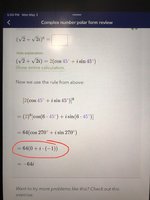Also can someone help me with equations that go like z5=32 because khan academy says the answer is 0.618+1.902i but I am so confused as to how to solve that
No, I don't believe that the Khan academy says that THE answer is 0.618+ 1.902i. Just as the quadratic equation, z
2= 4 has the
two solutions, 2 and -2, so a fifth power equation has
five roots ONE of which is (approximately) 0.618+ 1.902i. First, one obvious solution to z
5= 32 is z= 2 because 2
5= 2(2)(2)(2)(2)= 4(2)(2)(2)= 8(2)(2)= 16(2)= 32. Writing the complex number, z, in "polar form" where we write the complex number, \(\displaystyle z= a+ bi\) as \(\displaystyle z= r cos(\theta)+ i r sin(\theta)\), or, equivalently, \(\displaystyle z= re^{i\theta}\) where r and \(\displaystyle \theta\) are real numbers, r positive. Then \(\displaystyle z^5= r^5e^{5i\theta}= 32= 2^5= 2^5(e^{i0}\). Since r is a positive real number, r= 2. \(\displaystyle \theta= 0/5= 0\), which gives z= 2 but since \(\displaystyle \theta\) is an angle, adding \(\displaystyle 2\pi\) gives the same thing. But dividing by 5 gives different values.
\(\displaystyle (0+ 2\pi)/5= (2/5)\pi\). \(\displaystyle cos((2/5)\pi)= 0.3090\) and \(\displaystyle sin((2/5)\pi)= 0.9510\) so z= 2(0.3090+ 0.9510i)= 0.6180+ 1.9020i is another and that is what you are getting from Kahn academay.
A third root is given by taking \(\displaystyle 4\pi/5\). \(\displaystyle cos(4\pi/5)= -0.8090\) and \(\displaystyle sin(4\pi/5)= 0.5878\) so a third root is \(\displaystyle z= 2(-0.8090+ 0.5878i)= -1.6180+ 1.1756i\).
A fourth root is given by taking \(\displaystyle 6\pi/5\). \(\displaystyle cos(6\pi/5)= -0.8090\) and \(\displaystyle sin(6\pi/5)= -0.5878\) so a fourth root is \(\displaystyle 2(-0.08090- 0.5878i)= -0.1618- 1.1757i\)
A fifth root is given by \(\displaystyle 8\pi/5\). \(\displaystyle cos(8\pi/5)= 0.3090\) and \(\displaystyle sin(8\pi/5)= -0.9510\) so a fourth root is \(\displaystyle 2(0.3090- 0.9510i)= 0.6180- 1.9020i\).
Notice that if we tried this again, we would use \(\displaystyle 10\pi/5= 2\pi\) which would put us back to the real root, 2 again and then the same 5 roots repeat.

